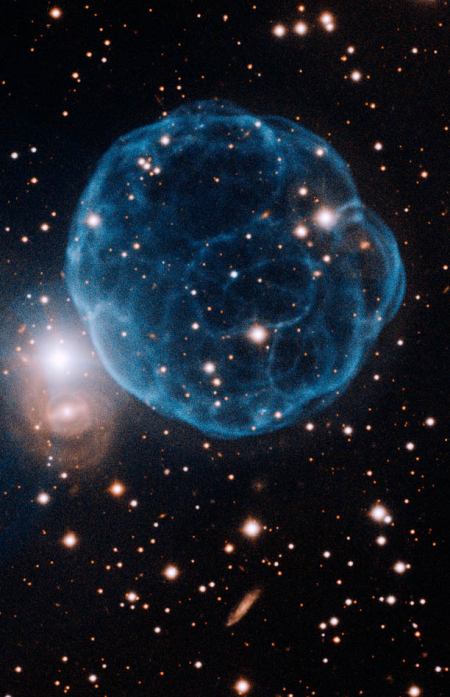Planetary Nebula Kn 61 Looks Like A Cosmic Soap Bubble.
Enlarge. | Via.
Check out Kn 61. It’s a planetary nebula that looks like those soap bubbles you can blow with those magical wands they sell at convenience stores and the like. Perhaps the Omnidimensional Creator had a son or daughter who was bored and it gave them the most enormous of soap bubble matter spewing wands. And thus Kronberger 61 was born. Or maybe it’s the remnants of gas that was sent into space by a dying star. I think I like my explanation more.
No Seriously, Bad Astronomy Explains:
In a nutshell, when a star runs out of useable hydrogen fuel in its core, it expands into a red giant and expels a huge wind of gas. This strips away the outer layers of the star, revealing the hot, dense core. Ultraviolet light from that star then lights up the surrounding gas, making these gorgeous nebulae.
The exact mechanisms for this process, however, are still not clear. I studied planetary nebulae (so-called because they sometimes resemble planetary disks through small telescopes) when I was in grad school, and a big question then was how the creation of these things depends on whether the central star was solitary, like the Sun, or had a companion (or planets). This relationship is still not clear, in fact, which is where Kn 16 comes in.
This nebula happens to be in the field of view of Kepler, an orbiting observatory that’s looking for planets around other stars. It’s staring at about 100,000 stars, looking for dips in light from the stars that indicate orbiting planets that periodically block the stars’ light. The central star of Kn 61 – the blue dot in the middle of the cloud – is being examined to see if it’s a binary or not. Professional astronomers have partnered with amateurs to do this, and Matthias Kronberger is a Swiss amateur who discovered this beauty.
The image uses filters that select the light from ionized oxygen (emitted very strongly by such nebulae) and hydrogen. I love the barred spiral galaxy just adjacent to Kn 61; the planetary nebula is in our Milky Way galaxy, but that spiral is probably tens of thousands of times farther away.
Pretty cool.




